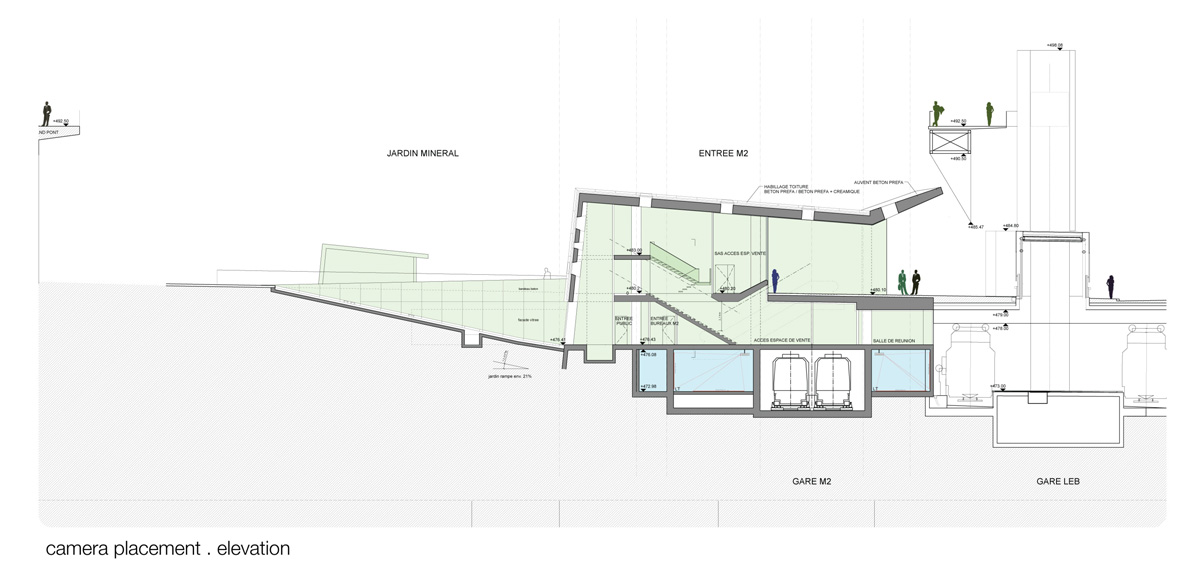Reactscape device:space
^c^v . specimen
This invited proposal for Lausanne Jardins 2008 questions the typical relationship between urbanity and landscape. The proposal exaggerates the object quality of the urban landscape by placing vegetation within a display case and monitoring it through video surveillance. The exhibit sterilizes and subdues the sublime, putting it on display for people to view and experience through the glass of the exhibit case. Typical qualities of “nature” are miniaturized, constrained and monitored creating a vegetative artifice.
The images captured from the encased vegetation are rebroadcasted through a series of projections located within the the underground space of the subway stations. The projections take the single image of the specimen tree replicating it throughout the underground space creating a landscape rich in color and change. The projections amplify the miniaturized scale of the exhibit and create a human scale landscape that can be occupied. This didactic relationship between encased vegetation and rich projections develops a dialogue about our view of nature and its qualities within the urban context.
exhibit
The proposal speaks to our definition of nature and richness in the landscape. The specimen plant becomes an exhibit, preserved for its precious quality. The specimen becomes the only vegetation in the proposal and functions as a manifestation of the artificial.
specimen planting
The specimen plant is noteworthy enough to stand on its own and is not planted in a massing. The specimen is usually grown for its ornamental form or unusual quality in the garden. The specimen in this proposal is comprised of a bonsai tree that is encased and displayed as a precious object within the urban context. The specimen is regarded as a single object, fawned over and cultivated to create an evolving perfection.
The proposal consists of a single plant, encased within a simple cube tilted on a corner increasing the spectacle of the artifice. The plant is a large bonsai Chinese Elme ‘ulums parvifolia’ standing approximately 60-75 cm. The plant itself stands as an ornament, representing our ability to tame the sublime through miniaturization and training.
The case for the plant increases the precious quality of the highly cultivated bonsai tree. The exhibit case consists of a 2m glass cube, secured within a stainless steel stand and tilted on one of its corners allowing it to stand 3.4m tall. The case appears balanced with the trunk of the bonsai aligned on the vertical axis between the corners of the cube. The case is vented through slits on the upper panels which also allows rainwater to enter the case.
The planting substrate is visible through the side of the glass panels showing root growth and layers of soil, perlite, medium gravel and course gravel. The bottom corner of the cube is allowed to drain in order to prevent flooding during large rain events.
monitor specimen
The specimen is monitored through a series of video cameras embedded in the middle corners of the exhibit case. The video cameras send images of the plant throughout the day and night to a nearby computer that is used to process and upload the photos for use in the projected landscape at Station Flon. The monitoring and surveillance of the miniaturized specimen emphasizes the object quality of the exhibit.
projection
The projections created in the subway stations create a rich, multi-faceted experience not normally available in this underground environment. The projections pull imagery from the monitored specimen plant above extracting the plantings silhouette creating a recognizable planting form that is then transformed and replicated to create a living digital landscape. Digital plants occupy the surfaces of the subway station changing based on the images captured and randomizing algorithms developed to create layers of planting. Each planting layer overlays on another creating a depth through overlapping layers. The colors slowly alternate as well as the transparencies creating a pulsating planting mass that appears to be rich with life.
Each projection is split between the floor and wall it is project upon. The projection is thrown across the floor and wall splitting the image as the point where the wall and floor meet. The split is used in the image processing to determine the planting shadow zone represented as the inverse color of the planting displayed on the wall above it. This also disrupts the focal length allowing the projection to be in focus on the wall and blurred on the floor.
The projections will also overlap the subway pushing the forest edge in towards the platform upon the arrival of the trains. This distortion pulls the forest edge to the platform and the subway doors open to allow passage through the edge.
relationship
The monitoring of the specimen plant placed within the urban context is stored and projected at the Station Flon and/or Riponne creating a relationship between the exhibit above ground and the projection below ground. Upon experiencing the project or the exhibit a visceral relationship between a recognizable and unique vegetative form is created allowing the patrons to infer a relationship between the two installations. This relationship between the accessible digital landscape and the constrained “natural” landscape allows the projections to function as facilitators for the specimen tree.




